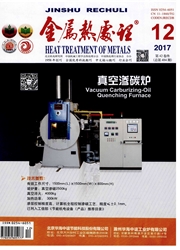

 中文摘要:
中文摘要:
采用EBSD分析方法,对CSP试验钢冷轧板退火过程中组织转变和再结晶织构的演变进行分析。结果表明,试验用钢的再结晶过程属定向形核,冷轧基体织构主要是成条状的{111}〈110〉、{111}〈112〉和{001}〈110〉取向。新的再结晶晶粒主要是{111}〈112〉和{111}〈110〉取向,且两种取向相互生成。在再结晶温度区间有利于形成{111}〈110〉和{111}〈112〉取向,在晶粒长大阶段会生成大量的对深冲性能无明显影响的{112}〈110〉取向转变。因此,控制再结晶温度区间内形成的{111}取向稳定存在而不发生转变,将有利于提高材料的深冲性能。
 英文摘要:
英文摘要:
The evolution of microstructure and recrystallization texture of CSP cold-rolled sheet during annealing were investigated by EBSD. The results show that recrystallization of the tested steel is oriented nucleation, the cold-rolling texture are mainly the { 111 } 〈 110 〉, {111 } 〈 112 〉 and { 001 } 〈 110 〉. The new recrstal grains are mainly the {1 11} 〈 112 〉 and { 111 } 〈 110 〉, this two textures are generated each other. The texture { 111 } 〈 112 〉 and { 111 } 〈 110 〉 easily occurs in recrystalline temperature, the texture{ 112} 〈 110 〉 is generated during grain growth which have no effect on deep drawing property. So it is favorable to increase deep drawing property that the { 111 } texture formed in recrystallization temperature is stability existed and does not changed.
 同期刊论文项目
同期刊论文项目
 同项目期刊论文
同项目期刊论文
 期刊信息
期刊信息
